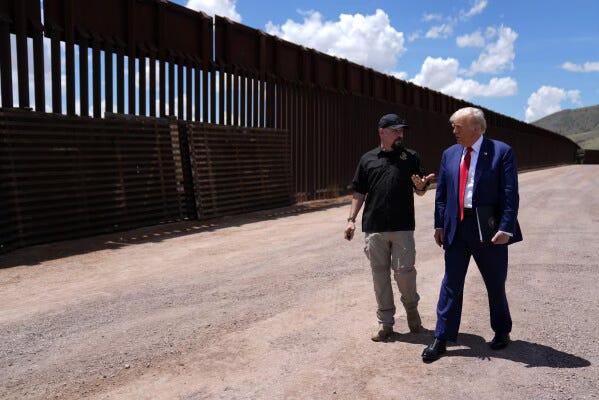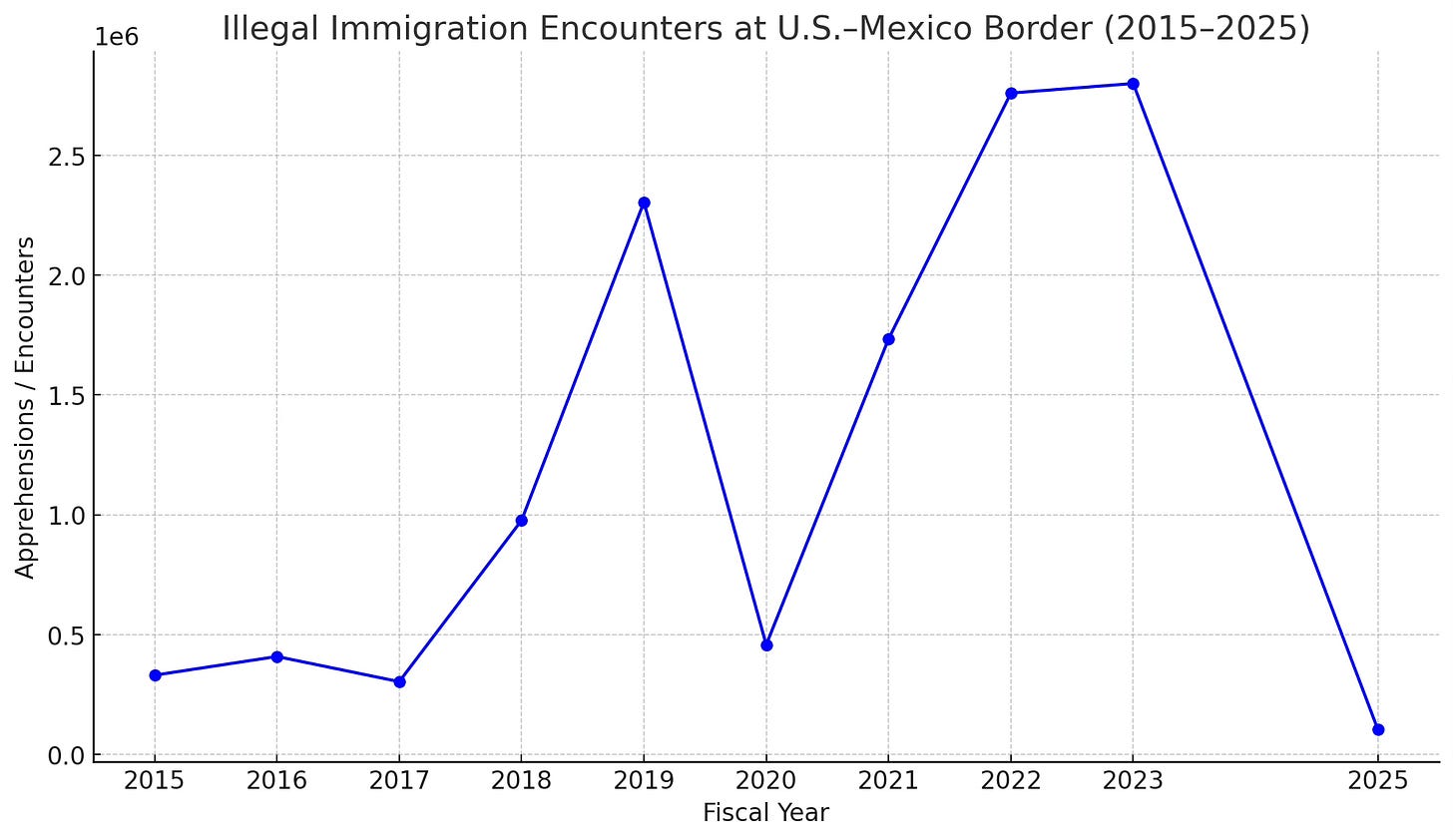Trump's Making a Dent on Illegal Immigration
By Rafael Benvente
Immigration Policy Changes Under Trump’s Second Term: A Comprehensive Overview
U.S.-Mexico border at dusk, symbolizing heightened security measures under Trump’s second term.
Since President Donald Trump assumed office for his second term on January 20, 2025, his administration has enacted a series of sweeping immigration policies, significantly reshaping the U.S. immigration system. These changes, driven by a campaign promise to prioritize border security and reduce both legal and illegal immigration, have sparked widespread debate, legal challenges, and economic concerns. This blog explores the key immigration policy shifts implemented in the first 100 days and beyond, their impacts, and the broader implications for immigrants, communities, and the U.S. economy, drawing on available data and historical context.
A Flurry of Executive Actions
From his first day in office, President Trump signed multiple executive orders and proclamations aimed at overhauling immigration policy. These actions, numbering over 21 in the first week alone, represent a sixfold increase in pace compared to his first term. Key measures include:
Border Security and Asylum Restrictions: Trump issued Proclamation 10888, "Guaranteeing the States Protection Against Invasion," which frames border crossings as a national security threat. This proclamation suspends asylum access for migrants at the southern border, expands expedited removal processes, and reinstates the "Remain in Mexico" policy, requiring non-Mexican asylum seekers to wait in Mexico during immigration proceedings. The CBP One app, previously used to schedule asylum appointments, was discontinued, stranding an estimated 270,000 migrants with canceled appointments.
Asylum seekers in Mexico, affected by the reinstated 'Remain in Mexico' policy.
Mass Deportation Efforts: Trump’s administration has prioritized deportations, targeting both undocumented immigrants and those with temporary statuses like Deferred Action for Childhood Arrivals (DACA) and Temporary Protected Status (TPS). Executive Order 14165, "Securing Our Borders," replaced "catch-and-release" with "catch-and-detain," mandating detention for immigrants awaiting removal proceedings. The use of military cargo planes for deportation flights and the invocation of the Alien Enemies Act to expedite deportations of alleged gang members, such as those sent to El Salvador’s megaprison, have raised concerns about due process violations.
ICE detention facility, central to the 'catch-and-detain' deportation strategy.
Birthright Citizenship and Legal Immigration: Trump issued an executive order attempting to end birthright citizenship for children of non-citizen parents, challenging the 14th Amendment. This move, widely expected to face legal challenges, signals an intent to restrict legal pathways. The administration has also reduced staff at U.S. Citizenship and Immigration Services (USCIS), exacerbating backlogs and limiting visa processing. Student visa revocations and threats to institutions like Harvard have further deterred international students.
Enhanced Vetting and Ideological Screening: Executive Order 14161, "Protecting the United States from Foreign Terrorists," mandates "extreme vetting" for visa applicants and immigrants present since January 2021. The Department of Homeland Security (DHS) now screens social media for activities deemed antisemitic or threatening, potentially delaying visa and green card issuance.
Impact on Border Crossings
The administration’s aggressive stance has led to a significant drop in border encounters. The chart below illustrates the trend in migrant apprehensions at the U.S.-Mexico border from 2020 to 2025, showing a sharp decline in 2025 following Trump’s policies.
U.S.-Mexico border wall, a focal point of Trump’s immigration enforcement policies.
U.S.-Mexico Border Apprehensions (2020-2025), showing a sharp decline in 2025. Data sourced from U.S. Customs and Border Protection (CBP).
The chart shows annual apprehensions between ports of entry, with data sourced from U.S. Customs and Border Protection (CBP) and other reports. In 2020, during Trump’s first term, apprehensions were approximately 458,088, dropping due to COVID-19 restrictions. Under the Biden administration, encounters surged, peaking at 2,475,577 in 2023. By June 2024, encounters fell to 1.44 million, reflecting Biden’s asylum restrictions and Mexico’s increased enforcement. In 2025, under Trump’s second term, monthly apprehensions plummeted to historic lows, averaging 7,200–8,400 from February to May, a 90%+ decrease from 2024 levels. For January–May 2025, an estimated 31,650 apprehensions were recorded, based on monthly averages.
However, this decline began in mid-2024 under Biden’s policies, suggesting that Trump’s measures amplified an existing trend. Factors like weather patterns, Mexico’s enforcement, and global migration dynamics also influence these numbers, complicating direct attribution
.
Economic and Social Implications
Immigrant communities contribute significantly to the U.S. economy and culture.
The economic consequences of these policies are profound. Immigrants, including undocumented workers, contribute significantly to the U.S. economy, with 47.1 million immigrants residing in the U.S. as of 2023. Mass deportations could exacerbate labor shortages, particularly in construction and healthcare, where immigrants make up a substantial workforce share. For instance, deportations may worsen housing shortages, as immigrants constitute a significant portion of construction workers. Additionally, undocumented immigrants contribute to the Medicare Trust Fund and Social Security, and their removal could hasten insolvency.
Socially, these policies have created a climate of fear. Immigrant communities report hesitancy to access jobs, schools, or public services due to increased ICE presence in sensitive locations like schools and churches. Legal challenges, such as those against Proclamation 10888, argue that these actions violate constitutional protections, including due process and the 14th Amendment. A federal judge in July 2025 ruled the proclamation illegal, though an appeal is pending.
Comparison to the First Trump Administration
During Trump’s first term (2017–2021), over 400 executive actions reshaped immigration policy, reducing legal immigration by 418,453 green cards and 11.2 million non-immigrant visas by November 2020, largely due to COVID-19 restrictions. However, illegal immigration remained stable, with interior removals dropping to their lowest since 2003. The second term’s policies are more aggressive, leveraging wartime laws like the Alien Enemies Act and involving the military, raising legal and ethical concerns.
Challenges and Resistance
The administration faces significant obstacles:
Legal Pushback: Lawsuits from immigrant rights groups and rulings like Judge Randolph D. Moss’s suspension of Proclamation 10888 highlight judicial resistance.
Logistical Constraints: Despite promises of 1 million annual deportations, current estimates suggest 500,000 deportations in 2025, below Biden’s 685,000 in FY2024.
Public Opinion: Polls show mixed support, with 75% of U.S. scientists considering leaving due to immigration policies, and a majority of independent voters disapproving of specific deportation cases.
Looking Ahead
While Trump’s policies have reduced border crossings and expanded enforcement, they fall short of the promised scale of mass deportations. Legal, logistical, and economic barriers, combined with public and judicial pushback, may limit their long-term impact. The administration’s focus on national security framing and archaic laws like the Alien Enemies Act marks a bold departure from precedent, but their sustainability remains uncertain. As the U.S. navigates these changes, the balance between enforcement and humanitarian obligations will continue to shape the national discourse.


